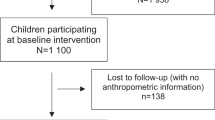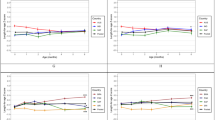Abstract
OBJECTIVE: To determine the types of subcutaneous adiposity represented by different measurements of skinfold thickness that are associated with birth weight in white (n=759), Black (n=916) and Hispanic (n=813) American children aged 5–11 y. We also determined the contribution of birth weight to ethnic differences in subcutaneous and central adiposity.
DESIGN AND METHODS: Data for this analysis were from the Third US National Health and Nutrition Examination Survey. The outcome measures were triceps, subscapular, suprailliac and thigh skinfold thicknesses at 5–11 y of age. Central adiposity was defined as ratios of subscapular to triceps (STR) and central–peripheral (CPR) (subscapular+suprailliac)/(triceps+thigh) skinfolds. Partial correlation analyses were used to determine the association between birth weight and measures of subcutaneous fatness, while multiple linear regression analyses were used to determine the independent contribution of birth weight to ethnicity variations in subcutaneous and central adiposity adjusting for sex, age and BMI.
RESULTS: Overall, birth weight was negatively associated with subscapular skinfold and central adiposity in White, Black and Hispanic American children (P<0.05). Birth weight was also negatively associated with suprailliac skinfold in both Blacks and Hispanics (P<0.01) and with sum of the four skinfolds in Blacks (P<0.05). Compared with White, Black ethnicity was negatively associated with triceps, suprailliac thigh and sum of skinfold thicknesses controlling for birth weight, sex, age and BMI (P<0.01). Compared with White, Hispanic ethnicity was negatively associated with triceps, thigh and sum of skinfold thicknesses (P<0.01). Both Black and Hispanic ethnicity was positively associated with STR and CPR (P<0.01).
CONCLUSIONS: In this population of American children, the association of birth weights with subcutaneous and central fat accumulation may be due to fetal programming. Since the impact of fetal conditions is likely to be modified by life course, defining the interaction between factors that are present at birth and subsequent exposures is one of the essential challenges for future research.
This is a preview of subscription content, access via your institution
Access options
Subscribe to this journal
Receive 12 print issues and online access
$259.00 per year
only $21.58 per issue
Buy this article
- Purchase on Springer Link
- Instant access to full article PDF
Prices may be subject to local taxes which are calculated during checkout

Similar content being viewed by others
References
Barker DJP . The fetal and infant origins of adult disease Br Med J 1990 301: 1111.
Curhan GC, Chertow GM, Willett WC, Spiegelman D, Colditz GA, Manson JE et al.Birth weight and adult hypertension and obesity in women Circulation 1996 94: 1310–1314.
Churchill D, Perry IJ, Beevers DG . Ambulatory blood pressure in pregnancy and fetal growth Lancet 1997 348: 7–10.
Dabelea D, Pettitt DJ, Hanson RL, Imperatore G, Bennett PH, Knowler WC . Birth weight, type 2 diabetes, and insulin resistance in Pima Indian children and young adults Diabetes Care 1999 22: 944–950.
Nelson RG, Morgenstern H, Bennett PH . Birth weight and renal disease in Pima Indians with type 2 diabetes mellitus Am J Epidemiol 1998 148: 650–656.
Barker D . Fetal nutrition and cardiovascular disease in later life Br Med Bull 1997 53: 96–108.
Phillips DIW . Birth weight and future development of diabetes Diabetes Care 1998 21 (Suppl 2): B150–B155.
Barker D . Fetal origins of coronary heart disease B Med J 1995 311: 171–174.
Cooper RS . Health and social status of blacks in the United States Ann Epidemiol 1993 3: 137–144.
Bjorntorp P . Abdominal fat distribution and disease: an overview of epidemiological data Ann Med 1992 24: 15–18.
Okosun IS, Prewitt TE, Liao Y, Cooper RS . Association of waist circumference with ApoB to ApoAI ratio in black and white Americans Int J Obes Relat Metab Disord 1999 23: 498–504.
Okosun IS, Cooper RS, Rotimi CN, Osotimehin B, Forrester T . Association of waist circumference with risk of hypertension and type 2 diabetes in Nigerians, Jamaicans, and African-Americans Diabetes Care 1998 21: 1836–1842.
Wei M, Gaskill SP, Haffner SM, Stern MP . Waist circumference as the best predictor of noninsulin dependent diabetes mellitus (NIDDM) compared to body mass index, waist/hip ratio over other anthropometric measurements in Mexican Americans—a 7-year prospective study Obes Res 1997 5: 16–23.
Velasquez-Melendez G, Martins IS, Cervato AM, Fornes NS, Marucci MF, Coelho LT . Relationship between stature, overweight and central obesity in the adult population in Sao Paulo, Brazil Int J Obes Relat Metab Disord 1999 23: 639–644.
Vague J . The degree of masculine differentiation of obesities: a factor determining predisposition to diabetes, atherosclerosis, gout, and uric calculous disease. 1956 J Clin Nutr 1956 4: 20–34.
Salans LB, Knittle JL, Hirsch J . The role of adipose cell size and adipose tissue insulin sensitivity in the carbohydrate intolerance of human obesity J Clin Invest 1968 47: 153–165.
Bjorntorp P . Fatty acids, hyperinsulinemia, and insulin resistance: which comes first? Curr Opin Lipid 1994 5: 166–174.
Evans DJ, Murray R, Kissebah AH . Relationship between skeletal muscle insulin resistance, insulin-mediated glucose disposal, and insulin binding: effects of obesity and body fat topography J Clin Invest 1984 74: 1515–1525.
Deurenberg P, Pieters JJL, Hautvast AJ . The assessment of the body fat percentage by skinfold thickness measurements in childhood and young adolescence Br J Nutr 1990 63: 293–303.
Matthes JW, Lewis PA, Davies DP, Bethel JA . Body size and subcutaneous fat patterning in adolescence Arch Dis Child 1996 75: 521–523.
Ezzati Tm, Massey JT, Waksberg J, Chu A, Maurer KR . Sample design: Third National Health and Nutrition Examination Survey Vital Health Stat 1992 2: 1–35.
National Center for Health Statistics . National Health and Nutrition Examination Survey III: Data collection forms National Center for Health Statistics: Hyattsville, MD 1991.
Hediger ML, Overpeck MD, Maurer KR, Kuczmarski RJ, McGlynn A, Davis WW . Growth of infants and young children born small or large for gestational age: findings from the Third National Health and Nutrition Examination Survey Arch Pediatr Adolesc Med 1998 152: 1225–1231.
Norusis MJ . SPSS 8.0 for Windows Release 8.0 SPSS Inc: Chicago, IL 1999.
Stein Z, Susser M . The Dutch famine, 1944–1945, and the reproductive process Pediatr Res 1975 9:: 70–75.
Emanuel I . An assessment of maternal intergenerational factors in pregnancy outcomes Am J Epidemiol 1997 146: 820–825.
Bock GR, Whelan J, Editors . Programming by early nutrition in man, In The Childhood Environment and Adult Disease John Wiley, Ciba Foundation Symposium 1997 156: 38.
Donker GA, Labarthe DR, Harrist RB, Selwyn BJ, Wattingney W, Berenson GS . Low birth weight and blood pressure at age 7–11 years in a biracial sample Am J Epidemiol 1997 145: 387–397.
MacDorman MF, Atkinson JO . Infant mortality statistics from the linked birth/infant death data set—1995 period data Mon Vital Stat Rep 1998 46 (6 Suppl 2): 1–22.
Hertz-Picciotto I, Din-Dzietham R . Comparisons of infant mortality using a percentile-based method of standardization for birthweight or gestational age Epidemiology 1998 9: 61–67.
Wise PH, Wampler N, Barfield W . The importance of extreme prematurity and low birthweight to US neonatal mortality patterns: implications for prenatal care and women's health J Am Med Womens Assoc 1995 50: 152–155.
Kerr GR, Verrier M, Ying J, Spears W . Proportional differences in births and infant mortality rates among the triethnic population in Texas from 1984 through 1986 Tex Med 1995 9: 50–57.
Vaucher YE, Harrison GG, Udall JN, Morrow 3rd . Skinfold thickness in North American infants 24–41 weeks gestation Hum Biok 1984 56: 713–731.
Malina RM, Huang YC, Brown KH . Subcutaneous adipose tissue distribution in adolescence girls of four ethnic groups Int J Obes Relat Metab Disord 1995 19: 793–797.
Baranowski T, Bryan GT, Rassin DK, Harrison JA, Henske JC . Ethnicity, infant-feeding practices, and childhood adiposity J Dev Beha Pediatr 1990 11: 234–239.
Malina RM, Katzmarzyk PT, Beunen G . Birth weight and its relationship to size attained and relative fat distribution at 7 to 12 years of age Obes Res 1996 4: 385–390.
Baker M, Robinson S, Osmond C, Barker DPJ . Birth weight and body fat distribution in adolescent girls Arch Dis Child 1997 77: 381–383.
Law CM, Gordon GS, Shiell AW, Barker DPJ, Hales CN . Thinness at birth and glucose intollerance in seven-year-old children Diabet Med 1995 12: 24–29.
Yanik CS, Fall CHD, Vaidya U, Pandik AN, Bavdekar A, Bhat DS, Osmond C, Hales CN, Barker DJP . Fetal growth and glucose and insulin metabolism in four-year-old Indian children Diabet Med 1995 12: 330–336.
Acknowledgements
Data from the NHANES III were obtained from the US National Center for Health Statistics. This work was supported in part by a grant from the National Heart, Lung, and Blood Institute (HL 45508).
Author information
Authors and Affiliations
Corresponding author
Rights and permissions
About this article
Cite this article
Okosun, I., Liao, Y., Rotimi, C. et al. Impact of birth weight on ethnic variations in subcutaneous and central adiposity in American children aged 5–11 years. A study from the Third National Health and Nutrition Examination Survey. Int J Obes 24, 479–484 (2000). https://doi.org/10.1038/sj.ijo.0801182
Received:
Revised:
Accepted:
Published:
Issue Date:
DOI: https://doi.org/10.1038/sj.ijo.0801182
Keywords
This article is cited by
-
Relationship between prenatal growth, postnatal growth and childhood obesity: a review
European Journal of Clinical Nutrition (2017)
-
Risk of childhood overweight or obesity associated with excessive weight gain during pregnancy: a meta-analysis
Archives of Gynecology and Obstetrics (2014)
-
Prenatal and postnatal programming of body composition in obese children and adolescents: evidence from anthropometry, DXA and the 4-component model
International Journal of Obesity (2011)
-
Maternal-recalled gestational weight gain, pre-pregnancy body mass index, and obesity in the daughter
International Journal of Obesity (2009)



